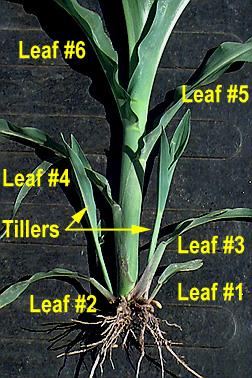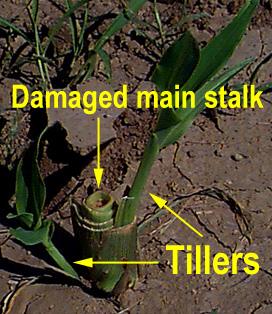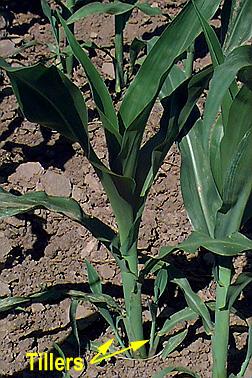Don't Call Me A
Sucker!
R.L. (Bob) Nielsen ,
Agronomy Department ,
Purdue University, West Lafayette, IN
47907-1150
Internet address: rnielsen@purdue.edu
- Tillers in corn signal favorable growing conditions.
- Tillers are not detrimental to main stalk.
Some of the guys over at the B&B Pitstop Cafe were arguing the other
day about 'suckers' in corn. The older fellows remember being sent to the
fields as kids to pull 'suckers' off the corn plants because their fathers said
'suckers' were bad for the corn, although some suspected that the real purpose
may have been to simply keep them out of their father's hair on hot, muggy
summer days. Well, what are 'suckers' and are they bad for corn?
'Suckers' Are 'Tillers'
 'Suckers' in corn are more properly
termed 'tillers' and are auxiliary corn plants that develop from one or more
stalk nodes (joints) at the base of the main stalk, one tiller per node.
Tillers become nearly independent plants as they develop, partly due to the
fact that they will eventually develop their own root system. Tillers may
compete somewhat with the main stalks, but given their late developmental start
they usually lose out in the competition for water, nutrients, and light.
'Suckers' in corn are more properly
termed 'tillers' and are auxiliary corn plants that develop from one or more
stalk nodes (joints) at the base of the main stalk, one tiller per node.
Tillers become nearly independent plants as they develop, partly due to the
fact that they will eventually develop their own root system. Tillers may
compete somewhat with the main stalks, but given their late developmental start
they usually lose out in the competition for water, nutrients, and light.
Tillering In Response to Damage
 One or more tillers commonly form if the
main stalk is injured or killed by hail, frost, insects, wind, tractor tires,
little kids' feet, deer hooves, etc. If the damage occurs early enough in the
growing season, such tiller development may result in harvestable ears. Late
tillering, however, usually doesn't allow enough time for tiller ears to
develop and mature before a killing fall frost. An example of late tillering
occurred in some Indiana fields damaged by the late June frost of 1992. The
apparent 'regrowth' of these fields looked promising from windshield surveys,
but little if any grain yield was obtained from these damaged fields.
One or more tillers commonly form if the
main stalk is injured or killed by hail, frost, insects, wind, tractor tires,
little kids' feet, deer hooves, etc. If the damage occurs early enough in the
growing season, such tiller development may result in harvestable ears. Late
tillering, however, usually doesn't allow enough time for tiller ears to
develop and mature before a killing fall frost. An example of late tillering
occurred in some Indiana fields damaged by the late June frost of 1992. The
apparent 'regrowth' of these fields looked promising from windshield surveys,
but little if any grain yield was obtained from these damaged fields.
Tillers on Normal Plants
 Tillers may develop in undamaged fields,
also. Most agronomists agree that such tiller development is a signal that
growing conditions are very favorable, with few limitations on available
nutrients, water, or light. Favorable growing conditions may exist simply due
to favorable weather conditions or because the plant population is too low for
the productivity level of the field. With favorable growing conditions, the
corn plant has ample energy and nutrients to 'invest' in tiller development.
Some hybrids are also genetically prone to developing tillers, even at adapted
plant populations.
Tillers may develop in undamaged fields,
also. Most agronomists agree that such tiller development is a signal that
growing conditions are very favorable, with few limitations on available
nutrients, water, or light. Favorable growing conditions may exist simply due
to favorable weather conditions or because the plant population is too low for
the productivity level of the field. With favorable growing conditions, the
corn plant has ample energy and nutrients to 'invest' in tiller development.
Some hybrids are also genetically prone to developing tillers, even at adapted
plant populations.
Bottom Line
As a rule, the end result of tiller development in an undamaged field is
neutral. Usually, the main stalk will outcompete the tillers and the tillers
eventually wither away. Tiller development in a field that was damaged or
simply planted too thin MAY result in harvestable ears and thus contribute to
grain yield.

For other information about corn, take a look at
the Corn Growers Guidebook on the World Wide Web at
http://www.agry.purdue.edu/ext/corn/
End of Document
 'Suckers' in corn are more properly
termed 'tillers' and are auxiliary corn plants that develop from one or more
stalk nodes (joints) at the base of the main stalk, one tiller per node.
Tillers become nearly independent plants as they develop, partly due to the
fact that they will eventually develop their own root system. Tillers may
compete somewhat with the main stalks, but given their late developmental start
they usually lose out in the competition for water, nutrients, and light.
'Suckers' in corn are more properly
termed 'tillers' and are auxiliary corn plants that develop from one or more
stalk nodes (joints) at the base of the main stalk, one tiller per node.
Tillers become nearly independent plants as they develop, partly due to the
fact that they will eventually develop their own root system. Tillers may
compete somewhat with the main stalks, but given their late developmental start
they usually lose out in the competition for water, nutrients, and light.  One or more tillers commonly form if the
main stalk is injured or killed by hail, frost, insects, wind, tractor tires,
little kids' feet, deer hooves, etc. If the damage occurs early enough in the
growing season, such tiller development may result in harvestable ears. Late
tillering, however, usually doesn't allow enough time for tiller ears to
develop and mature before a killing fall frost. An example of late tillering
occurred in some Indiana fields damaged by the late June frost of 1992. The
apparent 'regrowth' of these fields looked promising from windshield surveys,
but little if any grain yield was obtained from these damaged fields.
One or more tillers commonly form if the
main stalk is injured or killed by hail, frost, insects, wind, tractor tires,
little kids' feet, deer hooves, etc. If the damage occurs early enough in the
growing season, such tiller development may result in harvestable ears. Late
tillering, however, usually doesn't allow enough time for tiller ears to
develop and mature before a killing fall frost. An example of late tillering
occurred in some Indiana fields damaged by the late June frost of 1992. The
apparent 'regrowth' of these fields looked promising from windshield surveys,
but little if any grain yield was obtained from these damaged fields.  Tillers may develop in undamaged fields,
also. Most agronomists agree that such tiller development is a signal that
growing conditions are very favorable, with few limitations on available
nutrients, water, or light. Favorable growing conditions may exist simply due
to favorable weather conditions or because the plant population is too low for
the productivity level of the field. With favorable growing conditions, the
corn plant has ample energy and nutrients to 'invest' in tiller development.
Some hybrids are also genetically prone to developing tillers, even at adapted
plant populations.
Tillers may develop in undamaged fields,
also. Most agronomists agree that such tiller development is a signal that
growing conditions are very favorable, with few limitations on available
nutrients, water, or light. Favorable growing conditions may exist simply due
to favorable weather conditions or because the plant population is too low for
the productivity level of the field. With favorable growing conditions, the
corn plant has ample energy and nutrients to 'invest' in tiller development.
Some hybrids are also genetically prone to developing tillers, even at adapted
plant populations.